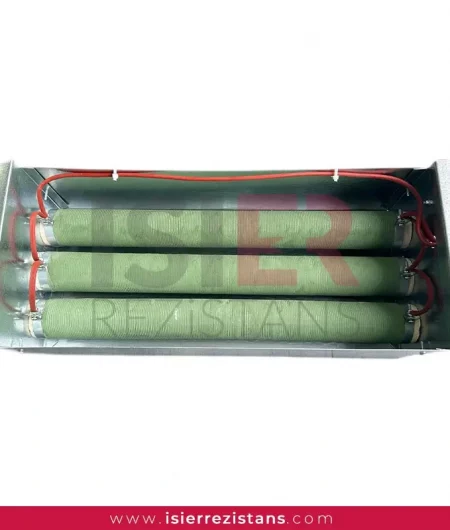Braking Resistor
A braking resistor is a component used in electric motors and electrical circuits. This resistor is used to control and stop the speed of the motor or circuit. When electric motors operate, they generate kinetic energy, and when it is necessary to stop or slow down this energy, the braking resistor comes into play.
Braking Resistor Technical Specifications
Energy Dissipation: When the motor is stopped, kinetic energy is converted into heat and dissipated in a braking resistor. This process allows the motor to stop more quickly and controllably.
Heat Management: The heat generated during braking is absorbed and dissipated by the braking resistor. Therefore, braking resistors are usually made of high-temperature resistant materials.
Providing Braking Force: Provides sufficient braking force to control the speed of the electric motor and stop it at the desired point.
Safety: In emergency stop situations, the braking resistor ensures that the motor stops quickly and safely, protecting both the motor and the connected system.
Applications: Braking resistors are used in various fields such as cranes, elevators, trains, electric vehicles, and industrial machinery.
The specifications and dimensions of braking resistors vary depending on the type of motor used, its power, and braking requirements. For example, larger and more powerful braking resistors are required for large industrial machinery, while smaller and lower-powered resistors may be sufficient for smaller devices.
What is the Purpose of a Braking Resistor?
Speed Control and Stopping: Braking resistors are used to control and stop the speed of electric motors. When the motor needs to be stopped, kinetic energy is converted into heat in the braking resistor, allowing the motor to slow down and stop in a controlled manner.
Energy Dissipation: Prevents system overheating by dissipating excess energy generated during motor operation. The energy produced during braking is converted into heat through the braking resistor and safely dissipated.
Safety: In emergency situations requiring immediate stopping, the braking resistor ensures that the motor stops quickly and safely. This is particularly important in industrial applications and transportation systems.
System Protection: Prevents damage to electric motors and connected equipment from sudden stops and speed changes. The braking resistor helps protect the motor and system in cases of overload and sudden stops.
Efficiency and Performance Improvement: The use of braking resistors can increase the efficiency of the motor and system. It prevents unnecessary overworking of the motor, saving energy costs and optimizing system performance.
What is the Importance of Braking Resistors?
Safety:
Emergency Situations: Braking resistors are vital for quickly and safely stopping motors in emergency situations, helping to prevent accidents and damage.
Controlled Stopping: Braking resistors enable motors to slow down and stop in a controlled manner, enhancing system and operator safety.
Equipment Protection:
Prevention of Overloading: Braking resistors prevent motors from being overloaded and the resulting damage. This extends the motor’s lifespan and reduces maintenance costs.
Heat Dissipation: Prevents overheating of motors and connected equipment by dissipating the heat generated during braking, thus preventing thermal damage.
Efficiency and Performance:
Energy Efficiency: Braking resistors prevent motors from working unnecessarily hard, thus saving energy. This reduces energy costs and increases system efficiency.
Speed Control: Allows precise control of motor speed, enabling processes to be carried out more efficiently and accurately.
System Stability:
Vibration and Noise Reduction: By reducing vibration and noise during motor stopping operations, braking resistors ensure a more stable and quiet system operation.
Dynamic Performance: Enhances system performance in applications requiring fast and sudden stops.
Various Application Areas:
Industrial: Used in cranes, elevators, transportation systems, and large industrial machinery. It is a critical component for the safe and efficient operation of these machines.
Transportation Systems: Provides safe stopping and speed control in transportation systems such as trains, trams, and electric vehicles.
Renewable Energy: Used for energy management and distribution in wind turbines and solar energy systems.
The functions and advantages provided by braking resistors make them an indispensable component in many industrial and commercial applications, enhancing both safety and system efficiency.
Braking Resistor Technical Details
The technical details of braking resistors may vary depending on specific applications, but there are some important technical specifications and parameters to consider regarding the design and function of braking resistors. Here are some technical details related to braking resistors:
Resistance Value (R)
Definition: The electrical value of resistance, usually measured in ohms (Ω).
Importance: The appropriate resistance value for the application helps the motor effectively manage energy distribution during braking.
Power Capacity (P)
Definition: The maximum power amount that the braking resistor can continuously dissipate, measured in watts (W) or kilowatts (kW).
Importance: It must have sufficient power capacity to safely distribute the heat generated during braking.
Maximum Operating Voltage
Definition: The highest voltage level at which the braking resistor can safely operate.
Importance: A maximum operating voltage higher than the system voltage ensures the resistor operates safely and reliably.
Heat Dissipation Capacity
Definition: The ability of the resistor to dissipate heat to the surroundings.
Importance: Effective heat dissipation during braking prevents resistors from overheating and getting damaged, especially in high-power applications.
Material and Construction
Definition: Braking resistors are typically made of high-temperature-resistant materials (e.g., stainless steel, ceramic).
Importance: Ensures the resistor’s longevity and durability.
Size and Mounting
Definition: Physical dimensions and mounting method should be suitable for the application.
Importance: Facilitates easy installation and integration of the resistor.
Cooling
Definition: Braking resistors may require effective cooling mechanisms (e.g., fans, cooling plates).
Importance: Necessary for effective heat dissipation, especially in high-power applications.
Protection Class
Definition: Protection classes like IP (Ingress Protection) rating indicate the resistor’s resistance to environmental factors.
Importance: Provides protection against dust, water, and other environmental factors.
Compliance and Certifications
Definition: Compliance with specific standards and regulations (e.g., CE, UL certifications).
Importance: Important for safety and compliance.
These technical details ensure that braking resistors meet the requirements of specific applications and operate reliably and safely.



